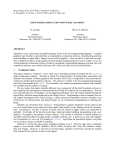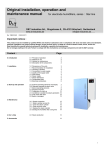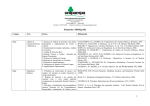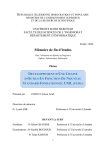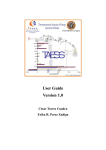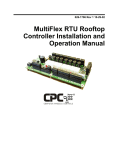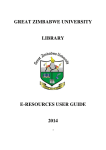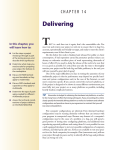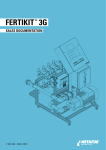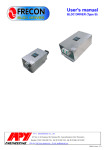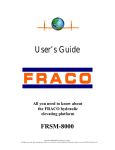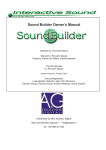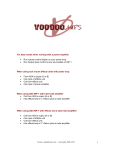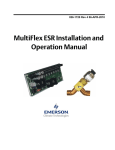Download M and Jam Factory
Transcript
M and Jam Factory Author(s): David Zicarelli Source: Computer Music Journal, Vol. 11, No. 4 (Winter, 1987), pp. 13-29 Published by: The MIT Press Stable URL: http://www.jstor.org/stable/3680237 . Accessed: 05/02/2014 08:09 Your use of the JSTOR archive indicates your acceptance of the Terms & Conditions of Use, available at . http://www.jstor.org/page/info/about/policies/terms.jsp . JSTOR is a not-for-profit service that helps scholars, researchers, and students discover, use, and build upon a wide range of content in a trusted digital archive. We use information technology and tools to increase productivity and facilitate new forms of scholarship. For more information about JSTOR, please contact [email protected]. . The MIT Press is collaborating with JSTOR to digitize, preserve and extend access to Computer Music Journal. http://www.jstor.org This content downloaded from 193.54.110.35 on Wed, 5 Feb 2014 08:09:18 AM All use subject to JSTOR Terms and Conditions DavidZicarelli Intelligent Music P.O. Box 8748 Albany,New York 12208 USA and Center for Computer Researchin Music and Acoustics (CCRMA) StanfordUniversity Stanford,California 94305 USA Introduction M (Fig. 1) and JamFactory (Fig.2) are the first software packages published by Intelligent Music, a company founded by composer Joel Chadabeto provide a commercial outlet for interactive composing software (Chadabe1984) and intelligent instruments. M and JamFactory,commercially available since December 1986, run on Apple Macintosh computers equippedwith a MIDIinterface (Chadabeand Zicarelli 1986, 1987). Both M and JamFactoryare programsthat, through the use of graphicand gestural interfaces, provide an environment for composing and performing with MIDI. The resulting environment, characterizedby controls that offer immediate feedback in modifying an ongoing process, is quite analogous to the control panel of an airplane. Indeed, one of the early models for the programswas FokkerTriplane, a flight simulation programfor the Macintosh. The original design for M was developed by Joel Chadabe,John Offenhartz,Antony Widoff,and me in early 1986. M is a specific embodiment of the kind of interactive composing system discussed by Chadabe,but the programhas grown into a laboratory for generating and processing MIDI far more complex and powerful than its original conception. JamFactoryis basedon an algorithmthat employs transition tables, also known as Markovchains. The motivation for writing JamFactorywas my interest in creating a programthat would listen to MIDI input and "improvise"immediately at some level of proficiency, while allowing me to improve its abilComputerMusic Journal,Vol. 11, No. 4, Winter 1987, ? 1987 MassachusettsInstitute of Technology. M and Jam Factory ity. This could be done by playing more notes or by adjusting the parametersof the algorithmic process while hearing the results of the process. Although it is clear that rules about musical practice (such as how to improvise) tend to limit the applicability of the algorithm to the aesthetics of the rulemaker, I hoped, by providinga wide and flexible range of controls, to give the user of JamFactorythe opportunity to personalize the results producedby the program. The rest of this article provides an overview of the current state of the development of both programs, and explains their architectures and some of the algorithms they employ. AStyleof Interactive Composing Chadabe(1984) describes a process of composing (which he calls "Design then do") where the composer uses some tools (a programminglanguage or an algorithm design application)to design a "composing machine," which has some elements that are determined by user gestures. The next phase of use is to test the machine by performingthe gestures. Usually the gestures adjust parametersor select different musical materials. In M and JamFactory,the distinction between the act of making the machine and using it are blurred. The programsthemselves are too general to be considered compositions per se, and it is entirely possible to modify the changeable parts of the "machine" in the "performance"such that you are performinganother machine. At certain times, the user is in the design stage, at others the user is in the performancestage. Because the program'smusical output immediately reflects a gesture made to Zicarelli This content downloaded from 193.54.110.35 on Wed, 5 Feb 2014 08:09:18 AM All use subject to JSTOR Terms and Conditions 13 Fig. 1. Main screen for M. r File Edit Variables Pattern MouieTester Windows Options - Input DEST ON SRC RNSP . " " :START/ .. . . .T . .......... ............. . . . .......C .. . . ......... . ...... ~TRL ....... ...... .... .. .. .. A . l T INPUTYEROUP MUTE l TYPE -- - -- All . . - - 19 - -2 190 2 . ? i ?? ? 4W 5W 6 2.8 00 g L... ..........:SYNC..,N . AP•.1 1 ? E L_._._._4__.1.. m 3- ..9 IN 'TE I $ITY7B• RANE . -- 1 6t 2 I8 c 2 18 f 1 , I6 1n II 1 IRANIOSTIO 0.0. . ? ....... SELECT. No ECHOM ... .. E• O(D • .YPE o "1 i - Patterns ........ NOTE )1---a 1, ------ IRDDENI1TY m ? . ---- i-- ----... something on the screen, many users can build a composition as a performance.M and JamFactory design activities can be viewed as performancegestures: the range bar (discussed later) is a primary example of this. Users can impose arbitrarydistinctions between composing and performingby restricting their actions at specific times. TheUserInterface The user interface for M and JamFactoryconsists of a number of objects arrangedas a graphic control panel drawn on the Macintosh screen. The control panel objects are manipulated (with a mouse, for example) to change parametersof an automatic musical process while that process runs, making music. A few characteristics of such objects include the following: 14 I, m.- H . l . . .. .. ... Each object communicates the currentvalue of a musical process parameterand imparts some knowledge of what would happen if the parameterwere changed. It is important that the programcommunicate to the user a range of possible courses of action to take, as well as allowing those actions to take place easily. Each object presents a musically powerful control that makes a perceiveddifferencewhen its value is changed. Specific control settings, and consequently specific states of the musical process, can be captured and retrieved. The graphicand operational nature of the objects themselves was extremely important in the design, and we found that the normal Macintosh Toolbox objects (such as scroll bars)were not suitable for an interactive music application. We developed a new Computer Music Journal This content downloaded from 193.54.110.35 on Wed, 5 Feb 2014 08:09:18 AM All use subject to JSTOR Terms and Conditions Fig.2. MainscreenforJam Factory. r * File Edit Options Configure P1P1 Silences: 100%9 'o 50% C1 Durations: 0% 1 Cycle 2 ol Lead Order 1 8 Quant Pitch 18 Pot Skip Sus Time: 02 1n116 111 1?.1 Movie 3 4 Dur ilI Stop_I Record -- Silences:Durations: 0% •• 10 Pot 1 Cycle50%• Ld Lead Order 1 2 Skip 2 ???I 0 PhasewI Swing I - 3 a , b' 0 Our i ------ -*-I--- SPhase, I wings - Echo OutCh InCh Pgm TransP Ctrl Play 3 /•07 P4 4///,• ! set of tools that operatesmoothly, take up less precious Macintosh screen real estate, and, most important, effectively communicate notions of algorithmic composition. The objects are implemented such that they can be scaled to any desired size and can take on a variety of appearances.They include range bars, numericals, choice bars, and button matrices (Fig.3). The range bar is a simple and elegant way of allowing a user to describe a range of values while succinctly communicating the idea of controlled automatic variation. The user "drawsout" the desired range by draggingwith the mouse from one end of the barto the other. In many cases, numerical displays (to show the values of both ends of the range)are changed as the mouse is being dragged. The numerical is a device for displaying and changing information representedas a number or as one of a small number of strings (such as "True," All 1 00 OO 0 Pct 1 Cycle0% 2 Skip Fol Lead Order 1 Sus 8t Quant Pitch : IIEIIIII 1Time --69 2 Silences:Durations: 50% 4 ??1 4 ********00000000 // = ' 50 0 l IIIIIIIIllllllli III Tempo T- /Tempo12/?P/01 llll llll p100% 3 O P3 i Time : 1na 1 SnI .Clear.P2 Pausea 3 Time: 1/ .LI?? 2 14 50 Swing 5$IR---.. Jam Factaory File: Untitled Go Rec Ctrl Silences: Durations: 50% 9 0 Pot 0% Cycle 2 Skip ILF ead Order 1 us Quant Pitch 3 00000000*0000 9 Phase~ 10099 ' P2 4 3 Dur i 5 Phase ** Swing a "False,"or "EitherIs Fine With Me"). The numerical usually is contained within a box that is drawn as part of a window's backgroundpicture. The value to be changed appearsin bold, and there is usually a legend indicating what it is that the number represents, which is not bold. Severalmethods can be used to change the value of a numerical: Holding the mouse button down in the top half of the box scrolls the value up by 1, and holding the mouse button down in the bottom half scrolls the value down by 1. Draggingthe mouse button above or below the outline of the box scrolls the value in direct proportionto the amount of mouse movement. Since it disappears,and since its motion is not confined by the screen boundaries,the mouse can move "forever." Zicarelli This content downloaded from 193.54.110.35 on Wed, 5 Feb 2014 08:09:18 AM All use subject to JSTOR Terms and Conditions 15 Fig. 3. Four of the choice facilities used in M and Jam Factory. (a) range bar. (b) numerical. (c) choice bar. (d) button matrix. (a) Minimumpossiblevalue (b) Increasewith gesture Scroll+ 1 onto another, for purposes of copying or swapping A choice bar, of sorts, that every Macintosh values. Maximumpossiblevalue user has seen is the palette of tools in the MacPaint program. The button matrix is a way of representingan on-off state for a set of items. The "on" state is represented by a graphic "pattern"chosen by the program designer, and the "off"state is shown as white. Legend Scroll- 1lw Cycle Current Decreasewith gesture TheImplementation Architecture value In JamFactory,the numerical can be selected and the value typed in with the Macintosh keyboardor, in some cases where a note is to be requested, played on a MIDI keyboard. Although it is not always the most suitable solution, the numerical can solve just about every user interface problem. It doesn't take up much screen space, and it offers the manipulation and gestural feedback possibilities of a scroll bar. I devised the numerical as a control in my DX/TX Patch Editor, published by Opcode Systems, and it has been adopted in a number of programssince that time. The choice bar is used to represent the selection of one out of a set of uniformly sized objects. I used it to represent M's variables, each of which has six possible values. To change a choice bar position, the user clicks on the desired position. The structure of a choice bar also makes it easy to dragone position In general, the Macintosh provides a very friendly environment for the development of interactive music programs.The computer is reasonablyfast and the screen is sharp enough to create a user interface of substantial detail and complexity. More importantly, the architecture of the Macintosh is set up to facilitate MIDI communication and highresolution timing of events. (Weare obliged to Dave Oppenheim, author of the Opcode Sequencer,for his work in developing the MIDI and timing routines we have used.) To send and receive characters, the MIDI driveruses serial chip interrupts that have a higher priority than the millisecond interrupts used for the computation of outgoing notes and processing of incoming notes. The millisecond interrupts are used in this way so that the program can play music and pay attention to the user at the same time. The various levels of operation are detailed in Fig. 4. Communication between levels is done through the use of message queues. The play and MIDI input handling routines use queues to request output (of a MIDI note, for example) or bufferinput from the MIDIdriver.A control queue is used to pass messages between the timer interrupt level and the main level. Since the processing of incoming MIDI data occurs at the interruptlevel, one extensive use of the control queue is to update the screen in response to MIDI control keys (called the input control system) or other MIDI notes which are received Communication from the by the interrupt rouinne. main loop to the interrupt is necessary in cases such as hitting the stop or start button or some user-triggeredtransmission of MIDI data (such as typing in a programchange). 16 Computer Music Journal (c) IrTRr SPOSITION // Alternativepositions (d) "Off"value \ Currentvalue Dragmouseto Record Play togglevalues "On"value This content downloaded from 193.54.110.35 on Wed, 5 Feb 2014 08:09:18 AM All use subject to JSTOR Terms and Conditions Fig. 4. Relationship of the processes in M and Jam Factory to facilitate interactive composition. The process activated in response to a serial interrupt transmits and receives individual characters of MIDI data. The process activated in response to a timer interrupt (shown by the eyes) observes the state of the musical global variables and calculates output or processes input accordingly. The mainlevel process (shown by the hand), which does not run at interruptlevel, allows the user to change the musical global variables, which in turn affect the calculations of the timer-interruptprocess. Serialinterrupt-level process: ReadsandtransmitsMIDI characters Queues Control queues Timerinterrupt-level process: * Readsglobalvariables andproducesMIDIoutput * Recordsandprocesses Main-level process: MIDIinput " Respondsto user's actions (mouse,keyboard)to change global variables. " ? .,•: .. ..... , - ..... J, .1" #"O <6_ rs ;> F ,d / 4eFIv" . 1, e J* *1 I ,. / ..... The majormethod of communication between levels, however, is that the user interface acts on the same set of global data that the interruptprocess uses to compute notes. When the mouse is used to change a parameterfrom 9 to 10, for example, the next time that parameteris used to compute a note, the change will be taken into account and heard. This seemingly simple idea is at the heart of the technique of writing programsthat play music that changes accordingto user input. In writing the code at the interrupt level, the goal has been to leave things in such a state that the computation of notes can be done in as little time as possible. In particular,a great deal of time has been spent eliminating costly 68000 multiply and divide instructions. For example, many commonly used ranges of pseudorandomnumbers (such as those between 0 and 100 for use in randompercentages) are computed when the programstarts up and read out from a cyclic table. Two routines run at interruptlevel. The tick routine services the data that needs to go out. It executes once every 96th of a quarter-note,with the actual number of milliseconds between ticks set by the tempo control. The recordroutine, which executes every 8 msec, services the queue of MIDI input. The basic tasks done by the tick routine are as follows: It increments the number of ticks since the user hit the start button. It checks to see if any note-offs are scheduled to be played, and if so, it plays them. Zicarelli This content downloaded from 193.54.110.35 on Wed, 5 Feb 2014 08:09:18 AM All use subject to JSTOR Terms and Conditions 17 Foreach pattern (M)or player (JamFactory),it decrements the time-base denominator and/or numeratorcounters, and if the numeratoris 0, it executes the note-playing routine and resets the counters. It checks if it is time to click the speaker for the metronome or send out a MIDI timing signal. It handles any requests for sending MIDI data, such as programchanges or other MIDI commands. The recordroutine checks to see if there is any data waiting in the input queue, and if so it does the following: If the data is MIDI timing information, it updates the synchronization counters and makes adjustments to the tempo. If the data is being echoed to the output port, it "rechannelizes"the data and sends it out. If the data is not a note or programchange, it's generally ignored (M has a "sequencer"mode where this information is recorded). It executes any recording,keyboardtranspose, or input control routines that may be enabled and applies them to the data. Some of these routines may place things in the control queue to request updating of the screen or other activities that cannot be performedin the interrupt. The main loop of the programis a typical Macintosh endless "event loop," which checks if there's anything that an interrupt routine has requested via the control queue, checks for running out of memory if it is capturinga performance(we call the captureof a performancea movie), and then handles any mouse, keyboard,or operatingsystem events. The Algorithms In designing M and JamFactory,various assumptions-effectively musical decisions-were made in orderto promote a user's ability to "get at" the music and change it interactively while maintaining significant control. First, changing the pitches in both programsconsists primarily of reordering.M uses a different re18 orderingscheme than the transition tables of Jam Factory,but in essence both programsachieve similar results. Reorderingis a powerful way of thinking about interactive control of pitch for the following reasons: It is extremely easy to make small changes in the parametersof the reorderingalgorithm to adjust the output to something more desirable. For example, in JamFactory,you can click on a picture of a bargraphto change the relative distribution of the ordersof the transition tables used. The perceptual effect of this is usually very obvious, and given that you hear the changes instantly, it is not hardto find a setting that is suitable for the material. Instead of having the computer work hard to come up with a variation appropriateto the style the composer has chosen to work in, the program gives a composer the ability to supply the essential information that can help make it appropriate. The user has control over the tonality of the piece by supplying the pitches to be reordered.Most composers would probablyagree that it is of higher importance what notes are played than what orderthey're played in, although this is a conjecture which should not (anddoes not) necessarily dominate the design of every algorithmic composing program. Yavelow (1987) points out that subtle reordering, such as the kind possible with transition tables, can be a substitute for direct repetition (or looping) of a phrase. Second, control over rhythm is approachedin both programson two levels. A master tempo, expressed in beats per minute, is translated into the amount of time for each tick, the smallest unit of time resolution. The time base modifies the tempo independently for each musical voice by expressing the number of ticks between events. The time base is representedas a rational expression, where the numerator ranges from 1 to 99 and the denominator is a fraction of a whole note selected from a list including 1, 2, 3, 4, 5, 6, 7, 8, 9, 11, 12, 13, 15, 16, and 24. The denominator translates into a number of ticks (for instance, a denominator of 4 = 96 ticks). Computer Music Journal This content downloaded from 193.54.110.35 on Wed, 5 Feb 2014 08:09:18 AM All use subject to JSTOR Terms and Conditions Fig.5. Theoriginalconception of conductingin M used the mouse to change parametersin a continuous fashionbasedon its Step advance is a special denominator where the user plays the durations on a MIDI keyboard. Each programhas its own method of handling durations above this level, but the effective duration will be a simple multiple of the time base. JamFactory allows furthercontrol overwhat could be termed "micro timing." Swing creates uneven eighth notes, and time distortion creates rubato over an arbitrary time period. These two features do not affect the overall speed of a process as would changing the time base. A GeneralDescription of M The basic idea of M is that a pattern (a pattern in M is a collection of notes and an input method) is manipulated by the various parametersof an algorithm. These parameters,in M, are called variables. Patterns are classified by input type (the way that the notes of the pattern are entered)as follows: Distribution patterns contain single notes and can be entered from a MIDI keyboardor by clicking on a skyline keyboardin a pattern editing window. The notes placed in two lists-the original list and the scrambledlist (which is a randomly reorderedversion of the original list). The pattern orderingvariable chooses a note from one of the two lists (or just randomly from the original list) using a distribution of percentages. Step record patterns are identical to distribution patterns except that chords can be entered (using a chord-detection algorithm) and the input must come from a MIDI keyboard. Drum machine patterns are either distribution or step recordpatterns which are initially filled with rests. Recordingtakes place in real time from a MIDI keyboardand new notes replace rests. Reorderingis done as follows: a third list contains the locations of all the nonrests in the original list, and creates the scrambledlist by swapping these locations. Thus, there isn't a reorderingof the positions of rests and notes. Real-time patterns are like traditional sequencer patterns, and bypass most of the M variables. positionin two dimensions. "Howcan we make a three-dimensional mouse?"we asked. Louder Volume 4 4 Tempo Softer Slower Faster They have an adjustablelength, can be quantized in real time, and can be speeded up or slowed down relative to the master tempo in certain basic ways. M provides facilities for manipulating pattern information, including copying, pasting, filtering, and editing. At the beginning of programdevelopment, M was oriented arounda large area in which the mouse would be used to change variablevalues. The concept is illustrated in Fig. 5. But as work progressed, we realized that this notion of conducting, in which the mouse gesture was encouragedto be continuous, was not appropriatefor all kinds of changes that were made in performance.We found, for example, that timbre selection (sendingMIDI program changes) was far better controlled with a discrete set of alternatives than in a continuum. Each M variablehas six positions, arrangedin sequential order,which contain alternative configurations of a particularparameter.Miniature representations of each of the six positions for all the variables are displayedon the main screen at the same time. One of these positions is highlighted, showing the currentvalue of the variable.To switch between the positions of a variable,the user merely clicks the mouse on the desiredminiature representation (which imparts predictive knowledge about the action-to-be).To edit the settings of one or more variablepositions, the user brings up an editing window that displays the information in a detailed textual and/or graphicform. If M is playing, and the selected position of a variableis edited, the changes are reflected immediately in the musical output. Zicarelli This content downloaded from 193.54.110.35 on Wed, 5 Feb 2014 08:09:18 AM All use subject to JSTOR Terms and Conditions 19 conduct a variable in one of four "directions,"which associate grid locations with variable positions. Here, the left-to-right direction is shown. Fig. 6. Currentconducting setup in M tracks the changing of discrete alternatives in variables with the position of the mouse in a grid. The user can Thus, the changing of the variables can happen both incrementally and interactively, and can be viewed as another kind of performancegesture besides that initially foreseen with the use of a conductor feature. The six positions of each variable correspondto the six units along either axis of the conducting area where mouse gestures are made, as shown in Fig. 6. Conducting variablesautomates the selection of variablepositions by mapping the mouse location in the grid to a variableposition. Next to each variable is a conducting arrow,indicating the direction of movement of the mouse with respect to the variable'scurrent value. If the arrowis highlighted, the variable is enabled for conducting, and the position will change in concert with mouse gestures in the conducting area. Any number of variables can be conducted simultaneously. Conducting thus becomes a way of selecting between discrete choices, ratherthan continuous modification of a parameter. The lone exception to this is tempo: conducting changes the tempo within a range drawn out by the user. The tempo range is scaled to equal the size of the conducting grid. M consists of four patterns, which sound simultaneously, and each pattern contains a separatevalue at each variableposition. For example, Fig. 7 shows two positions of the note density variable,which controls the percentageof random "skips" that occur in playing a pattern. In Fig. 7, position 1 can be interpretedas follows: pattern 1 plays all the time, patterns 2 and 3 play very rarely,and pattern 4 doesn't play at all. Thus switching to position 1 of the note density variable causes pattern 1 to play much more than all the other patterns. Switching to position 2 effectively shuts off all patterns except pattern 4. A special variable called a pattern group contains the musical material that the four patterns play. Each pattern in a group could be considered a kind of track in a typical MIDI sequencer, but it is really more of a collection of notes or chords. The M algorithm attempts to "animate"these collections into music, adding rhythm, articulation, and dynamics. Each variablehas a miniature representation on the main screen. We've tried to give each type of variable its own graphicidentity, and continue that identity into the variable editing windows. Each "row"in a miniature representationor editing window represents the information for each pattern. The orchestration variable (Fig.8) assigns patterns to MIDI channels (usually different synthesizers). It takes the form of a 4-by-16 matrix in which each of the four patterns can be assigned to any or all or none of the 16 MIDI channels. The sound choice variable actually contains 16 arrays;in each are stored sets of MIDI program changes which change the timbre of a synthesizer. These programchanges are sent every time a new sound choice alternative is selected. The note density variableis the percentage of time that notes of each pattern are played. When the value is less than 100, a probabilistic algorithm decides whether to skip a note based on the percentage. The transposition variable contains an offset, expressed as a note above or below middle C, which is added (or subtracted)to the note values of each pattern. A cyclic distribution is a data structure that has some number of scalar values or randomranges that are read out once each tick of a clock. In M, these structures are applied to duration, articulation (le- 20 Computer Music Journal Conductinggrid ....... ........... ... .............. ..................... ....... Baton cursor ". . ...... .. ..... ...... ....... left to right TIN RANGE NmT EIS Variable_4T•TEm name I _we __0" / 3._3% N Variablepositions Currentvalue (highlighted) representations) (minature This content downloaded from 193.54.110.35 on Wed, 5 Feb 2014 08:09:18 AM All use subject to JSTOR Terms and Conditions SNoteDensity 0 25 50 75 25 - 32 - NOjT,TE 0 00 ". ........ ............ ........... -100 - -- --O -I • iC- Note Density [_ 100 25 . 50 .i -- F1I DENSITYL Fig. 9. The Cyclic Editor allows interactive editing of cyclic distributions applied to duration patterns, articulation (called legatostaccato), and velocity (called accent). The window displays one position of one of these variables which consists of four distributions, one for each pattern. The user can bring up for editing one of the six positions for any of the three variables on the right hand side of the window. The column of numericals on the far right translate the levels of the durations and legatostaccato variables into actual values. The editing of the distributions takes place on the left side of the window. Fig. 8. Edit window of the orchestration variable. Fig. 7. Miniature representation and edit window display of two notedensity-variable positions. I, ! 75 100 ....... -"~~ o:! I--I gato versus staccato), and accent (MIDIvelocity). The implementation of these structures is quite simple, but they provide an elegant method of controlling variation through randomness. Figure 9 shows an editing window for a cyclic distribution. Time is horizontal, value (called level) is vertical. The levels can range from 0 to 4. Each level is defined in terms of an absolute value; for example, the levels for Legato-Staccatoare mapped into percentages chosen by the user. A level of 0 might be 10 percent of the time between the beginning of the note and the beginning of the next note; a level of 4 might be 300 percent (in which case the notes will overlap).The levels don't need to be assigned to values in ascending order, so it's possible to weight the randomness by assigning the same value to more than one level. One position of a cyclic distribution variable contains distributions for four patterns. Each distribution has a unique length, so patterns cycle through their distributions independently. The Cyclic Editor (shown in Fig. 9) shows the distributions for each of the four patterns. The length of the solid grid shows the length of the cycle, and the gray squares indicate the levels. Levels that extend over more than one square indicate random ranges. These variables work together as the parameters of the M algorithm. The algorithm's computation of pitch, timing, and velocity is charted in Fig. 10. Fig. 8 Orchestration _O__ 1 E 3 4 MIDI CHANNEL 1 8 9u 11 121H 13 sI 15 5s Fig.9 _ _ _- Cyclic Editor _ 14 1 I 2lDURATIONS a 1 3 1 2 3 41 5 "1 1 3=1 2= 3 101112131415T 1 150 116250 1 3 I1I 3 1 E3 325 5 I 13 I 3 I II.o II 4 5 6 1 8 9101112131116 Fa 1 2 3 Sa 4 s 1 1 1 om1lanllSml Zicarelli This content downloaded from 193.54.110.35 on Wed, 5 Feb 2014 08:09:18 AM All use subject to JSTOR Terms and Conditions a = a T0 21 mation. (a) Pitch computation. (b) Timing computation. (c) Velocity computation. Fig. 10. The interaction of M variables in the computation of pitch, timing, and MIDI velocity infor- (b) (a) Pattern(note list) Original list Tempo (beatsper minute), determines msecs per tick @ 96 ticks per beat Scrambledlist Levellookuptable Pattern ordering Timebase (1/4 = 96 ticks) 54 % 31 Durationcyclicdistribution 3 15 5 9 3 = 2.5 = 1.5 2 • 1 2 3 4 561 1516 1"1011121314 " Total duration = 2.5 * 96 = 240 ticks Is note played? Transposition NOTE OCTAUE Patternmute E4i +/ Orchestration '1 5 1 2 1A MIDI CHANNEL B1 1 1 1 1112113 1 15 It "5 1 17 7 1 I 1 1I I . .. .. Note density 1 ! !i 0 1 Note played on MIDI channel 1 -32 25 50 75 100 .......................i j Accent cyclic distributionlevel = 0 (c) Accent cyclic distribution 3 : i1 a3 s 56 1 :. 11 1 2 3 4 5 11 Bg 101112131 4151 :::: 3 31i 151 e n10111 10 duration off Orchesttal Intensity range I 1491I Lookup table Articulation time = 240 ticks* 250 percentable ArNote-on-Note-off 250 1 3 i' 5"1B 15 1 31811111 Velocityconductingoffset +/ a= 600 ticks =-600 ticks 22 Computer Music Journal This content downloaded from 193.54.110.35 on Wed, 5 Feb 2014 08:09:18 AM All use subject to JSTOR Terms and Conditions Fig.11. Assignmentsmade to eachkey on the keyboardfor the inputcontrol system. Settings of variables can be groupedas a snapshot, which can be recalled to select those settings simultaneously. A snapshot is made by clicking on the hold/do button (which begins to blink), then changing the positions of variables that are to be grouped together, each of which starts to blink when selected. Then the desired location (there are 26, labeled A-Z) for the snapshot is selected in the snapshot window, which stops all the blinking and creates the snapshot. The purpose of the snapshot is to enhance the gestural capability of the user, which is otherwise limited to either the changing of variable positions that are linked in position by conducting, or selecting variable positions one at a time directly with the mouse. The snapshot can be used to create sections of a piece delineated with combinations of sounds or musical material. In both M and JamFactorya control mode called the input control system is used to allow MIDI input to triggercertain programactions. Figure 11 shows the assignment of keys to various input control functions in M. The music can be stopped and started, variablepositions can be changed, patterns muted, and so forth. Three other features are more gestural in nature: Step advance triggersthe choosing and playing of the next event in one or more patterns. The note is played when the performerdepresses one of the assigned step advance keys, and is turned off when the key is released. The note is also played with the velocity that the key was depressedwith. Step advance keys are grouped as two contiguous white notes so that successive notes can be played rapidlyusing a twofingered technique. Each pattern has its own step advance keys, so any number of patterns can be performedin this manner, theoretically by more than one person. Tap tempo allows the tempo to be set from a MIDI keyboard:the time between two successive taps of the assigned key is measured and taken to be the time of a quarter-note. Continuous tap tempo (for lack of a better word) follows the performerprecisely in tapping out a tempo. Although the system does not try to pick up the tempo if no tap is received, it is ContinuousTap Accelerando FreezeTempoif Tapping Z Y X Snapshot(A-Z) Decelerando W Step AdvanceVoice 4 StepAdvanceVoice 4 U Hold / Do V Accent T StepAdvanceVoice3 tep AdvanceVoice 3 ync DuLegato/StaccatS R Durations $'-TR Sync Advanceall "sa"Voices Densnsity16(Q)tep15(P) StepAdvanceall "sa"Voices IntensityRange 14(0) Start(MiddleC) Note stop S(N Voice2 StepAdvance Transpositio2(M Orchestration SoundChoice(1-16 Voice2 11(L)StepAdvance 10(K)TapTempo (J) StepAdvanceVoice 1 8 () StepAdvanceVoice 1 7 (H ClearCurrentPattern4 (if recording) PatternOrdering9 PatternGroupSelect T6(G ClearCurrentPattern3 (if recording) 5 (F)Clear CurrentPattern2 (if recording) 4 (E)Clear CurrentPattern1 (if recording) 3 (D) Voice 4 MuteToggle 2 (C) Voice 3 MuteToggle 1 (B)Voice 2 MuteToggle 0 (A) Voice 1 MuteToggle TimeBaseVoice 4 TimeBaseoice TimeBase oice 1 f Values of keys for selectingVariables(Snapshots) possible to freeze the tempo with another key. Two other keys bump the speed of the frozen tempo up or down, like a kind of gestural accelerando/decelerando.Another addeddimension is velocity conducting, which adds an offset to the velocity of the currently playing notes, determined by the velocity of the performer'stap. A GeneralDescriptionof JamFactory JamFactoryconsists of four players, each of which holds an input stream of pitches and durations, each with its own set of transition tables. In addition, each playerhas other output controls that employ algorithmic devices to provide other kinds of Zicarelli This content downloaded from 193.54.110.35 on Wed, 5 Feb 2014 08:09:18 AM All use subject to JSTOR Terms and Conditions 23 Fig. 12. The states of the Jam Factory transition tables when computing pitches based on an input of C-sharp,D, E, D, F. Contains notes afterF Contains notes afterE, F Contains notes afterD, E, F Contains notes afterC-sharp,D, E, F Order 1 transition table Order 2 transition table Order 3 transition table Order 4 transition table Previousnotesplayed ..., C-sharp,D, E, F Probabilitydistributionfor choice of tables what transition table to use. This is possible beeasily manipulated automatic variation. Controls for the players are located in windows in each corcause every time a note is recorded,entries are ner of the screen. A long window in the center, made in all the active tables; this creates something like multiple "views" of the same object. called the control strip, handles starting and stopfuncthe and the On playback, a bufferof the last four notes the assigning program'sclock, ping tions of MIDI IN and OUT for each player. The algorithm has producedis kept around, so that the conof all the the states store information necessary to "research"the previous player presets, which of the the bottom states for any ordertransition table is available. Betrols, are housed in a window at screen. Some noninteractive screens are broughtup cause of this, any of the tables can be used to generfrom menu commands which configure memory ate the next note at any time. The probabilistic use, set performancetriggers,set player note limits, decision is based on a bar graphwhich can be maand create maps for scale and time distortion. nipulated directly by the user while the algorithm The transition table is a way of storing the proba- operates, allowing a fine tuning of its performance. What is the effect of alternating between the use bility that a certain action happenedgiven some number of previous actions. The subject of transiof one table and another?One way to illustrate it is tion tables and Markov chains has been well covwith a major scale that ascends and then descends ered (Olson and Belar 1961; Pinkerton 1956). [See (Fig. 13a).When the bar graphis set at 100 percent also Hiller 1970; Hiller and Isaacson 1959; Moorer Order 1 (Fig. 13b), the output exhibits a wandering based on the "local phenomena"-transitions of ei1972; Xenakis 1971-Ed.] Here I will review the basics and point out some techniques that assist in ther up or down one note. As you begin to introthe real-time implementation used in JamFactory. duce Order2 transitions (Fig. 13c) the output begins to take on more of the ascending then descending The orderof a table refersto the numberof events of the original input. Since an Order2 trannature in a "previousaction" that the next action sitting table sition in the table happened after. Figure 12 shows the encompletely captures the information to tries in transition tables of orders 1-4 for an exnecessary recreate the scale, no "mistakes" are made if the bar graphis set at 100 percent Order2 ample input sequence of C-sharp,D, E, D, F. An essential part of the JamFactoryalgorithm is (Fig. 13d). With more complex source material, it is not as the probabilistic decision made on every note as to 24 Computer Music Journal This content downloaded from 193.54.110.35 on Wed, 5 Feb 2014 08:09:18 AM All use subject to JSTOR Terms and Conditions Fig. 13. The effects of transition-table processing. (a) Source material: an ascending and descending C major scale. (b) Sample output based on input of (a) for completely Order 1 transition table decisions. (c) 80 percent Order2, 20 percent Order 1 decisions. Note that the output of (c) more closely resembles the input over a longer period of time than does (b). (d) 100 percent Order2 decisions reproduce the ascending and descending scale exactly. (a) Inputsourcematerial transitiontableoutput (b) First-order Startingover transitiontableoutput (c) Primarilysecond-order (d) All second-order output I MI 3k easy to describe the effect of different settings of the bar graph,but it is not difficult with the feedback providedto try different configurations until one that produces reasonableresults is found. For many applications, 70-80 percent Order2 with the rest divided between Orders 1 and 3 will blend "mistakes" with recognizable phrases from the source material in a satisfying manner. The transition table scheme is duplicated for durations (the time between successive notes). Since there are an infinite number of possible durations, some kind of data reduction scheme has to be employed. JamFactoryhas a quantization algorithm that forces notes into chords (pitch events in the transition tables can be polyphonic) and creates du- rations of at least 1 "unit."The unit of quantization is set as a note value (i.e., eighth notes). The more precise the quantization value, the "longer"each duration becomes, as illustrated in Fig. 14. Since the durations are expressed in units that multiply the time base, it is necessary to adjust the time base to equal the quantization value if the resulting music is to be played at the same speed as the original. One particularenhancement of the duration scheme is worth mentioning. It combines information about a duration with the position of a duration within a cycle. As an example, a duration of 3 followed by a duration of 2 might turn into a duration of 3 on count 1 of the cycle, followed by a duration of 2 on count 4 of the cycle. This extra "position" constraint has the effect of insuring that notes of a certain duration always begin in a place in the cycle where they happened in the original input signal. A parameterin each player'swindow controls the length of this cycle. JamFactoryprovides objects for enhancing the output of the transition tables. The goal of the enhancements is to process the raw material and give it the air of an individual performance(although there is no provision for having the players actually listen to each other). The controls fall into these categories: the silences algorithm, velocity/articulation, micro timing, and live performanceprocessing. The silences algorithm is basically the same thing as note density in M, but it is represented backwards(the percentageis of silence, not playing), and includes a couple of useful switches that add variety to a performance.Skip, when enabled, causes the next note in the sequence from the transition tables to be "thought of" when it isn't played (producingthe effect of skipping a note in the melody). Sustain, when enabled, sustains any notes that might be playing through a random silence, giving the impression that the notes have a longer duration, rather than there just not being a note there. Combinations of having these two effects on and off produce a variety of "playingstyles." JamFactory'scontrol over velocity and articulation for each player is very similar to the scheme used in M. There is a repeatingpattern of levels, analogous to a cyclic distribution with the excepZicarelli This content downloaded from 193.54.110.35 on Wed, 5 Feb 2014 08:09:18 AM All use subject to JSTOR Terms and Conditions 25 creasing the value of each event's duration when increasing the quantization resolution. Fig. 14. Two possible quantizations of a sequence of note attacks showing the effect of in- QuantizationresolutionX: J J Original I J J I/ input timing I I i I J / 1 I J J J I I J JJ 1 I I I Quantized output (notesin chord) 1(1) 1(1) 1(1) 1(1) 1(2) 1(1) 111) 1(1) I 1(2) Quantizationresolution2X: J Original J J timing input J J V J JJ / Quantized output (notesin 2(1) 2(1) 1(1) 1(1) 3(1) 2(2) 4(1) 3(3) chord) tion that the levels are always deterministic. The absolute levels of velocity and articulation (percentage of time between successive notes beforethe note is stopped) are set using range bars. If the repeating pattern is not applied to one of these parameters, the values vary randomly within a range. If the pattern is applied, the values are extracted from within the range bar in the same way that M's intensity range interacts with the accent cyclic distribution. Swing and time-distortion manipulations are efforts to move away from the feeling of a mechanized performance.Since they can be set differently for each player, the collective effect from all four players can be that of an ensemble, rather than that of a bunch of notes being triggeredfrom a single clock. Swing is simply a distortion of the time given to two notes to emulate the long-short feeling popularly known as swing. It is expressed in terms of the percentage of the total time for the two notes taken up by the first note; thus, no swing would be 50 percent. In JamFactory,unlike the implementation of swing (or "shuffle")on many drum machines, the value can range from 10-90 percent (values below 50 percent could be thought of as "inverse swing"). Time distortion is a more general-purposemethod of manipulating micro timing. It is an implementation of the time maps proposedby David Jaffeas a method for producingthe perception of ensemble performance(Jaffe1985). The user creates time maps using a graphiceditor, and sets a length of time over which the map will apply (maps repeat, like almost everything else). Maps that are the length of two time-base units in a player are equivalent to swing, while maps covering longer periods of time can be characterizedas rubato. Since a player can have both some swing and an active time map, you can have a feeling of rubato on top of a feeling of uneven eighth notes (Fig. 15). Time distortion is implemented by creating a 26 Computer Music Journal This content downloaded from 193.54.110.35 on Wed, 5 Feb 2014 08:09:18 AM All use subject to JSTOR Terms and Conditions Fig. 15. Computation of timing information in Jam Factory. Forlive performanceprocessing, the programdoes a certain amount of differentiationof MIDI input to Tempo(beatsperminute),msecspertick make it possible to use multiple keyboardsand/or @ 96 ticks perbeat performers.Each player has a column in the control strip labeled "In Ch" which can either be set to "All" or to a specific channel. MIDI input can be Time distorts number of ticks per map: STMap time basedenominator used in four ways: As source material for one or more players (i.e., "recording") F19IPhase Phase:initial delay(in ticks)when To performkeyboardtransposition (expressedan 4 starting offset from middle C) As JamFactory'sversion of the input control Time: system 3 1161 Timebase(1/4 = 96 ticks)* To echo the input to the player'sMIDI output channel Tempo IIIlllllllllll 11201 IIIIIIIIIII Swing:shiftseveryotherevent 167 Swing (percentageof time fortwo events The assignment matrix in the control strip enables these tasks for each player'sMIDI IN channel. The first three uses of MIDI input are mutually exclusive. Control presets reconfigurethe assignment of Silences: Durations: MIDI input. A control preset has a trigger(which Transitiontable can be any arbitraryMIDI event), which, when decalculationof tected, changes the assignment matrix to a previdurations ously stored state. Thus you can go from recording 1009% Skipsevents to transposingwithout having to touch the Macinaccordingto tosh keyboardor mouse. percentageof 50 Keyboardtransposition has an addedwrinkle silence O0 known as scale distortion. Using the scale distorOrder 1 2 3 4 tion configurationwindow, you create remappings I15 Pct of the chromatic scale. Forexample, if the program were to play an F-sharp,you could force it to play an F. There are eight scale maps, which can be assigned to a key in the chromatic scale. When that key is played as a playeris being keyboardtable that has as many entries as there are ticks (re- transposed,the map is activated. The result is that the tonality of the music changes but not the apcall 1 tick = 1/96th of a quarternote) in the map. is the tick for a the time executed, processing parentmelodic "motion."Yavelow(1987)observes: Every table entry is read saying how many ticks to "simu- "... this process permits, for example, the transforlate." If the map is slowing down real time versus mation of highly chromatic music into diatonic clock time, there will be table entries of 0, causing music, quick conversion of music from minor to the player to do nothing at that moment in time. major scales and back, or styles which are scale/ When the map is speeding up real time, there will mode defined to be represented."A scale distortion be entries of 2 (or perhapsmore), in which case the map is implemented as a table of positive or negative offsets for each MIDI note number. If a map player does twice as much as it normally would. Table entries of 1 do not speed up or slow down the converted each F-sharpto F, the entry would be -1 for all MIDI notes that were F-sharp. player. givento the firstevent) Zicarelli This content downloaded from 193.54.110.35 on Wed, 5 Feb 2014 08:09:18 AM All use subject to JSTOR Terms and Conditions 27 MIDIFiles Both M and JamFactoryimplement the MIDI File standard.MIDI Files are a way of storing MIDI sequences in a way that is publicly documented and easily read and written, so that programsthat deal with sequence data can exchange it. Usually, programs store data in formats besides the MIDI File format to preserve other kinds of information (the currently implemented standardhas no notion of hierarchical sequence structure, for example). M and JamFactoryboth have their own document format, which stores information such as the values and contents of M's variables and the mapping of MIDI events to entries in JamFactory'stransition tables. But importing and exporting sequence information is also supported,so that the programscan pass musical material to each other or to other programs that currently support the format, among them Opcode'sSequencer2.5 and Southworth's MIDI Paint. The programscontain a "movie" mode wherein every MIDI event that occurs in a performance is captured,along with the time it occurred.The events can then be saved as a MIDI File or, in M, regurgitatedback into a pattern. The importation of sequence data is used as source material for the players in JamFactory,and as real-time patterns in M. Since M allows one kind of pattern to be converted to another, data from a MIDI file can be treated with the same amount of flexibility as any other kind. Dave Oppenheim, the author of Sequencer2.5, developed the MIDI File format primarilybecause he realized that he wouldn't be able to implement every feature into his programthat his customers wanted, and thought that it would be helpful if users who were also programmerscould make their own use of the file format. The ability of M and JamFactoryto read and write MIDI Files has been largely responsible for their popularity with people who saw them as ways to make movies of what they often call "texture" to be used as tracks in their sequences. There is also the possibility of notating material created with the programs using Electronic Arts' Deluxe Music Construction Set in conjunction with the Opcode Sequencer. 28 The opportunities created by the MIDI File specification are applicablewithin the modular concept of MIDI in the largest sense. Prospective developers of music software are now free to work on a specific problem, knowing that there are other software packages which can take care of tasks they may not have the interest or time to worry about. It is, in other words, no longer necessary to write programs that purportto be "generalpurpose."We may get to the point where there are hundredsof little, specialized programssharinginformation using MIDI Files; but this seems to me to be entirely healthy, since there are as many ways of using a computer to produce music as there are computer users. Reflections An audience listening to a "finished"piece of music, whether by purchasingrecordingsor attending performances,can be said to have "consumed"a product. Traditional music software programs,such as sequencers, are tools that make products. M and JamFactory can be used to create fixed pieces of music, but comments from users (of the type "I'm having a great time with your program"more often than "I'mmaking great music with your program") indicate that these programsare an intertwined mixture of process and end-results. The programs provide enjoyment because their processes provide discovery and the pleasure of performance,and this enjoyment is enhanced if the user is satisfied with the music that is being produced. In publishing M and JamFactory,Intelligent Music's intention was to create, for the professional musician, enjoyablebut powerful composing and performingtools which would enhance creativity. The value (andenjoyment) in these programsderives from the programs'participationin the composing process, which is to say that the programs share in making "decisions," at least in the sense of presenting to the composer or performerpotentially usable ideas. But such a situation poses some ethical questions. If tools allow a composer or performer to produce music in a matter of minutes that might have taken weeks to do beforehand, should the composer or performer be rewarded for ComputerMusic Journal This content downloaded from 193.54.110.35 on Wed, 5 Feb 2014 08:09:18 AM All use subject to JSTOR Terms and Conditions this activity at the same level? Is this activity still "composing"or "performing"and is the result something that a composer or performercan "own," as a product?What credit should go to the program designer?Laurie Speigel asks that she and her program Music Mouse be credited in performances (Speigel 1986). To the authors of M, the issue seemed reasonably clear: their intention was to produce a general-purposeprogram,usable by any composer in any style, and their rewardwas to be the wide variety of music producedby users of the program. The company had another intention, however, which was to test the applicability of the approach to amateur music-making. Just as the radio and recordplayer allowed more people to enjoy musical performances,the interactive composition environment combined with an inexpensive synthesizer may allow a wider audience to experience the act of composing or improvising, in which case the "power"in the programsmight make up for deficiency in performanceskill. The potential benefits in this approachmust yet be verified. But then we are still learning. In making a program into a commercial product, you further its development tremendously through your interaction with a large number of users. However, the time involved in perfecting a new idea in the form of commercial software leaves you with years' worth of ideas and user suggestions to implement. Acknowledgments I would like to acknowledge Joel Chadabefor his help in the organization and editing of this article. The encouragement of Dr. Earl Schubert,my advisor in the Programin Hearing and Speech Sciences at StanfordUniversity, was also very helpful. Many of the ideas presented here were formulated and refined in discussions with JohnOffenhartzand Antony Widoff,and I would also like to acknowledge the help providedby the reactions of those who worked with the programsas they developed, including Dave Oppenheim, Doug Wyatt, Jeffrey Rona, David Bluefield, ChristopherYavelow,and Jim Burgess. References Chadabe,J.1984."Interactive Composing:An Overview." ComputerMusic Journal8(1):22-27. Chadabe,J.,andD. Zicarelli.1986.JamFactoryUser's Manual.Albany,New York:IntelligentComputerMusic Systems,Inc. Chadabe,J.,andD. Zicarelli.1987.M User'sManual.Albany,New York:IntelligentComputerMusicSystems, Inc. Hiller, L. 1970. "Music Composed with Computers-A Historical Survey."In H. Lincoln, ed. 1970. The Computer and Music. Ithaca: Cornell University Press. Hiller, L., and L. Isaacson. 1959. ExperimentalMusic. New York:McGraw-Hill. Jaffe,D. 1985. "EnsembleTiming In Computer Music." ComputerMusic Journal9(4):38-48. Moorer,J.A. 1972. "Music and Computer Composition." Communications of the Association for Computer Machinery 15(2):104-113. Olson,H., andH. Belar.1961."Aidto MusicCompositionEmployinga RandomProbability System."Journal of the Acoustical Society of America 33(9): 1163-1171. Pinkerton, R. 1956. "InformationTheory and Melody." Scientific American 194: 77-86. Speigel, L. 1986. Music Mouse User's Manual. Palo Alto, California:Opcode Systems. Xenakis, I. 1971. FormalizedMusic. Bloomington: In- dianaUniversityPress. Yavelow,C. 1987."Personal ComputersandMusic."Journal of the Audio EngineeringSociety 35(3): 161-188. Zicarelli This content downloaded from 193.54.110.35 on Wed, 5 Feb 2014 08:09:18 AM All use subject to JSTOR Terms and Conditions 29


















